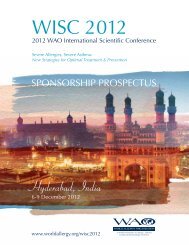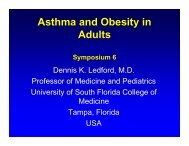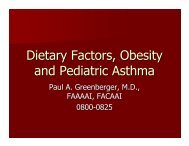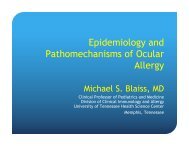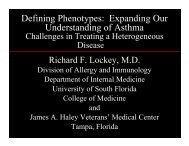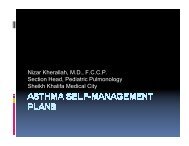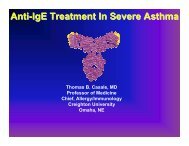Dubai Final-v20.indd - World Allergy Organization
Dubai Final-v20.indd - World Allergy Organization
Dubai Final-v20.indd - World Allergy Organization
You also want an ePaper? Increase the reach of your titles
YUMPU automatically turns print PDFs into web optimized ePapers that Google loves.
ABstrACts<br />
ABstrACts<br />
1320<br />
il-17 DriVES THE rECrUiTmEnT oF B CEllS To THE BronCHial TiSSUE oF SEVErE aSTHmaTiC PaTiEnTS<br />
Halwani, r. 1 , Al-muhsen, s. 2 and Hamid, Q. 3<br />
1Asthma research Chair and Prince naif Center for immunological research, College of medicine, King saud University., riyadh,<br />
saudi Arabia. 2Department of Pediatrics, College of medicine, King saud University. 3mcgill University, meakins-Christie laboratories,<br />
montreal, Canada.<br />
Background: B-cells play an important role in asthma development mostly via the production of igE. A number of reports have<br />
shown local production of igE in B cells present in lung tissues of mild allergic asthmatics. However, it is not clear whether there<br />
is an increase in the number of B cells in severe asthma and how do B cell migrates to the mucosal site. Our objective in this<br />
study was to determine the number and pattern of infiltrated B cells into lung tissues in severe compared to mild asthma and to<br />
investigate the mechanism behind this infiltration.<br />
methods: Bronchial biopsies from severe versus mild asthmatics were stained for B cells marker (CD20) using<br />
immunohistochemistry. moreover, migration towards il-17 gradient was determined using Boyden chamber.<br />
results: the number of CD20 positive cells in severe asthmatic biopsies was significantly higher than those in mild asthmatics.<br />
interestingly, we have also observed lymph follicles in 40% of severe compared to 15% of mild asthmatic airways. most of<br />
the cells in the lymph follicles were CD20 positive cells. these lymph follicles were very close to the epithelial surface. We<br />
have recently reported high expression of il-17 in severe asthma. We tested the hypothesis that il-17 is involved in migration<br />
of B cells to the mucosal surface of the airways. Although B cells were shown to migrate towards both il-17A and il-17F,<br />
much lower concentrations of il-17F, compared to il-17A, were sufficient to induce migration. moreover, B cells within airway<br />
mucosa of severe asthmatics were shown to express higher level of il-17r compared to those of mild asthmatic patients using<br />
immunohistochemistry as well as qPCr.<br />
Conclusion:il-17 might drive the migration of B cells in the lung tissues and could play a critical role in the formation of lymphoid<br />
follicles in severe asthmatic airways.<br />
1321<br />
EoSinoPHilS EnHanCE airWaY SmooTH mUSClE CEll ProliFEraTion<br />
Halwani, r. 1 , Al-muhsen, s. 2 and Hamid, Q. 3<br />
1Asthma research Chair and Prince naif Center for immunological research, College of medicine, King saud University.,<br />
riyadh, saudi Arabia. 2Department of Pediatrics, College of medicine, King saud University. 3mcgill University, 2meakins-Christie laboratories, montreal, Canada.<br />
Background: Asthma is a chronic inflammatory disorder of the lung airways that is associated with airway remodeling and<br />
hyperresponsiveness. its is well documented that the smooth muscle mass in asthmatic airways is increased due to hypertrophy<br />
and hyperplasia of the Asm cells. moreover, eosinophils have been proposed in different studies to play a major role in airway<br />
remodeling. Here, we hypothesized that eosinophils modulate the airways through enhancing Asm cell proliferation. the aim of this<br />
study is to examine the effect of eosinophils on Asm cell proliferation using eosinophils isolated from asthmatic and normal control<br />
subjects.<br />
methods: Eosinophils were isolated from peripheral blood of 6 mild asthmatics and 6 normal control subjects. Asm cells were<br />
incubated with eosinophils or eosinophil membranes and Asm proliferation was estimated using thymidine incorporation. the<br />
mrnA expression of extracellular matrix (ECm) in Asm cells was measured using quantitative real-time PCr. the effect of<br />
eosinophil-derived proliferative cytokines on Asm cells was determined using neutralizing antibodies.<br />
results: Co-culture with eosinophils significantly increased Asm cell proliferation. However, there was no significant difference in<br />
Asm proliferation following incubation with eosinophils from asthmatic versus normal control subjects. Co-culture with eosinophil<br />
membranes had no effect on Asm proliferation. moreover, there was no significant change in the mrnA expression of ECm proteins<br />
in Asm cells following co-culture with eosinophils when compared with medium alone.<br />
Conclusion: Eosinophils induces Asm cell proliferation independent of direct cell to cell contact or ECm synthesis. Eosinophils may<br />
induce Asm proliferation via the secretion of proliferative cytokines.<br />
www.worldallergy.org 108<br />
FinAl PrOgrAm



